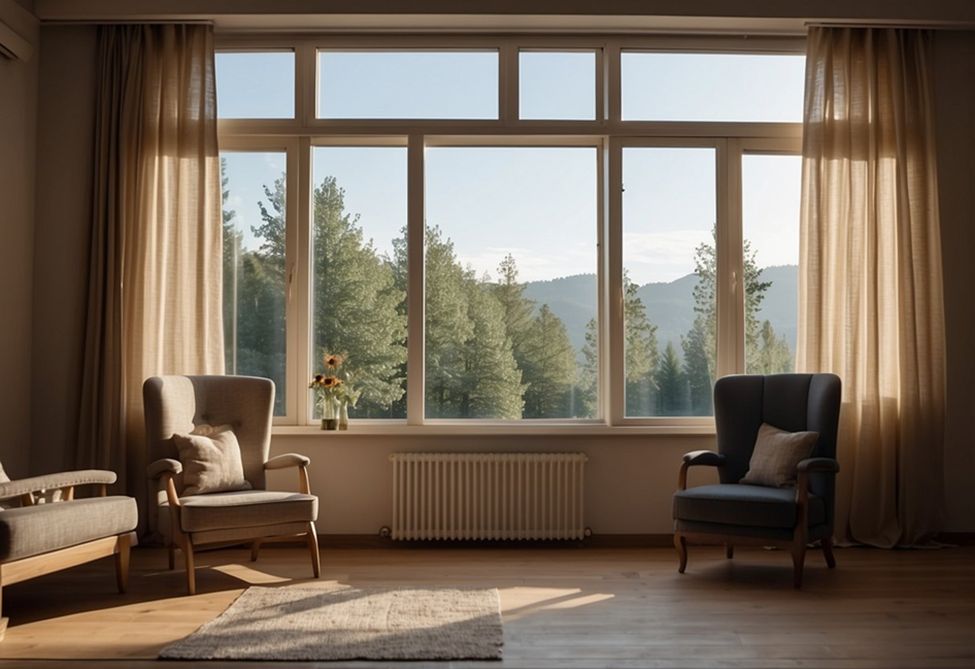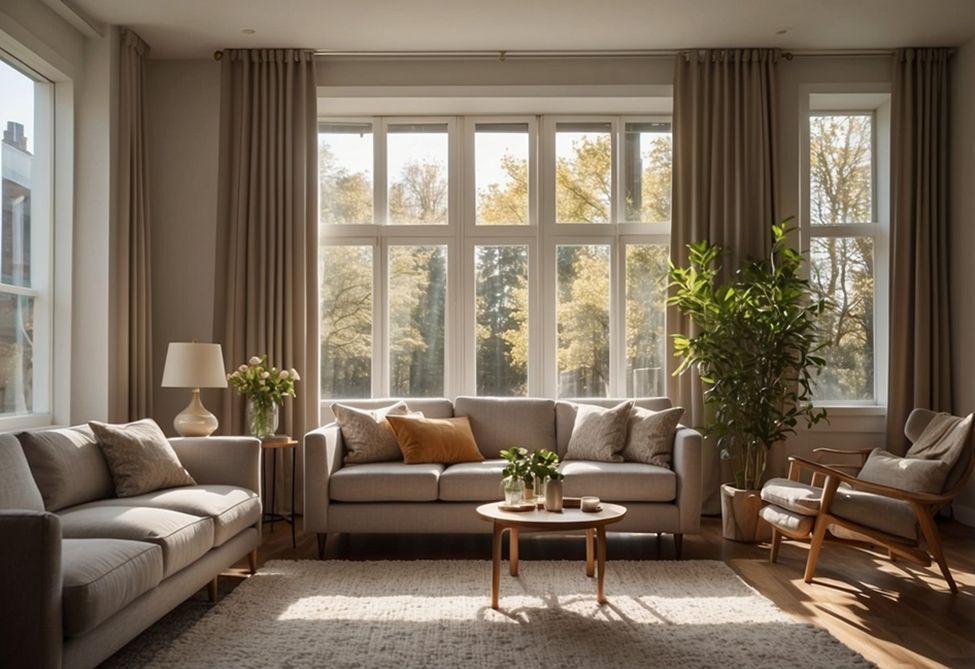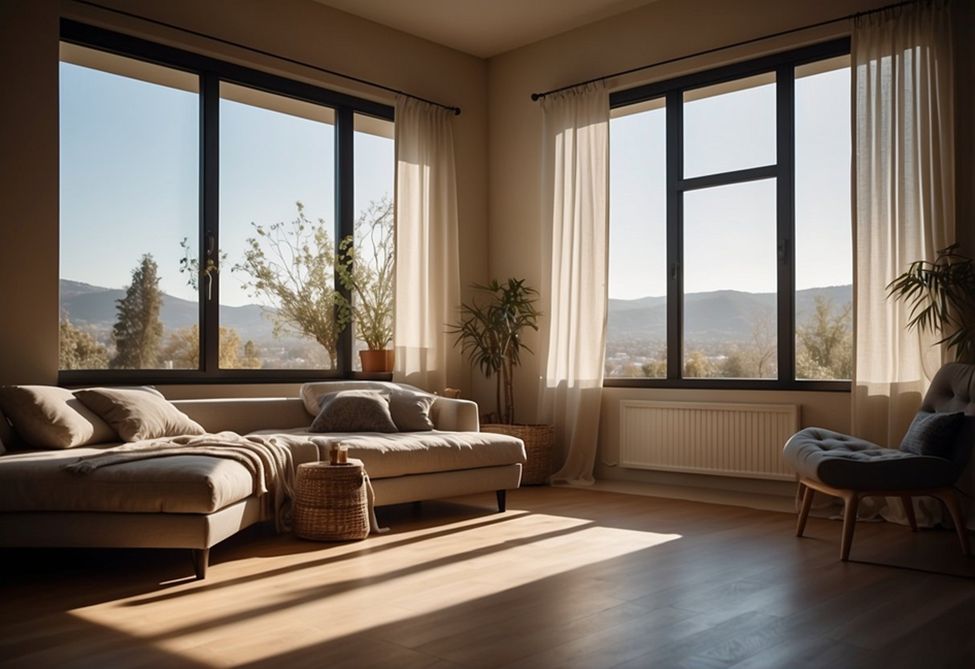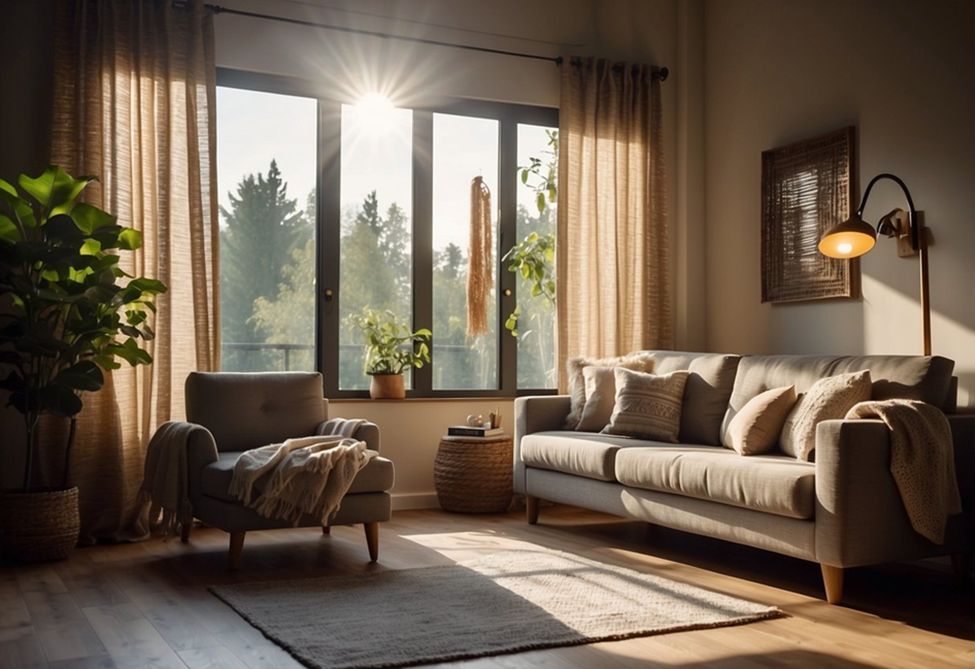Choosing window coverings for your home is an important decision. Curtains and blinds are two popular options, each with its own strengths. The right choice depends on your needs and style.
Picking between curtains and blinds involves considering factors like light control, privacy, and maintenance.
Both options can look nice in a home, but they work differently. Comparing curtains and blinds can help you decide which is best for each room.
1) Light Control

Light control is a key factor when choosing between curtains and blinds. Both options offer ways to manage sunlight, but they work differently.
Blinds provide precise light control. You can adjust the slats to let in just the right amount of light, making them great for rooms where you need to fine-tune brightness throughout the day.
Meanwhile, curtains offer a more all-or-nothing approach to light control. When open, they let in lots of light. When closed, they can block out light more effectively than blinds. This makes curtains ideal for bedrooms or media rooms where total darkness might be desired.
Some people choose to combine blinds and curtains for maximum light control options. This setup allows for versatility in managing natural light throughout the day.
The choice between curtains and blinds for light control depends on your needs. Consider how much flexibility you need to adjust light levels in each room of your home.
2) Energy Efficiency

Window coverings play a big role in a home’s energy use. Both curtains and blinds can help save energy, but they work differently.
Curtains are good at keeping heat in during winter. Thick curtains can reduce heat loss by up to 10%. They work best when closed at night and on cold days.
On the other hand, blinds are better for summer cooling. When closed, they can cut solar heat gain by up to 45%. Light-colored blinds reflect more sunlight, keeping rooms cooler.
Some blinds are more energy-efficient than others. Cellular shades are top performers. They trap air in their honeycomb cells, acting like insulation.
Proper use matters, too. Opening curtains or blinds on sunny winter days lets in free heat, while closing them on hot summer days keeps rooms cooler.
For best results, homeowners can use both curtains and blinds. This combo offers year-round energy savings. It also allows for more control over light and temperature.
3) Cost

The price of window treatments can vary widely. Blinds and curtains both have different costs and fit different budgets.
Basic plastic or vinyl blinds are often the cheapest option, starting at around $8 per window without installation. Higher-end wooden blinds or custom-made options can cost over $200 per window.
Curtains also have a wide price range. Simple ready-made panels may cost as little as $20-$50 per window, while custom curtains from luxury fabrics can exceed $1,000 for a single window.
Installation adds to the total cost for both options. Professional curtain hanging typically costs $15-$150 per window, and blind installation may cost $35-$100 per hour.
Motorized blinds are pricier, ranging from $400-$600 for interiors and $1,000 or more for exterior options. These provide convenience but at a higher upfront cost.
When budgeting, consider the number of windows you need to cover. The total cost can add up quickly for larger homes or rooms with many windows.
4) Aesthetics

Aesthetics play a big role in choosing between curtains and blinds. Both options can change how a room looks and feels.
Curtains come in many fabrics, colors, and patterns. They can add warmth and softness to a space. Thick, heavy curtains can make a room feel cozy, while light, sheer curtains can make it feel airy and bright.
Blinds, on the other hand, offer a sleek, modern look. They are made of wood, metal, or plastic.
Blinds can blend in with a room’s decor or stand out as a feature. Vertical blinds work well for large windows and sliding doors.
Some people like to mix curtains and blinds for a layered look. This can add depth and interest to a room’s design.
The choice between curtains and blinds can change how light enters a room. This affects the overall mood and feel of the space. Blinds offer more control over light, while curtains can create a softer glow.
5) Installation

Installing curtains and blinds requires different approaches. Curtains often need a curtain rod mounted above the window frame, which involves drilling holes and securing brackets.
Blinds, meanwhile, are typically mounted inside or outside the window frame. Inside mounting provides a sleek look, while outside mounting covers the entire window. Blinds usually come with mounting brackets and screws.
Both options can be installed DIY. However, blinds can be trickier, especially for larger windows or specialty shapes. Curtains are generally easier for most homeowners to install.
Professional installation is available for both curtains and blinds. This option ensures proper fit and function, particularly for complex window treatments or hard-to-reach areas.
Some blinds come with a quick-install feature, making them faster to put up. Meanwhile, curtains may require more time to hang and adjust to achieve the desired look.
Weight is another factor to consider. Heavy curtains need sturdier hardware and extra support, while lightweight blinds are generally easier to handle during installation.
6) Maintenance
Keeping window treatments clean is an important factor to consider. Blinds and curtains have different maintenance needs.
Blinds are generally easier to clean. A quick dusting or wipe-down with a damp cloth is often enough to keep them looking fresh. Many types of blinds can also be vacuumed with a brush attachment.
Curtains typically require more effort to maintain. They may need to be taken down and washed or dry-cleaned periodically. This can be time-consuming and potentially costly.
Some curtain fabrics are more prone to collecting dust and allergens than blinds. This can be a concern for people with allergies or respiratory issues.
Conversely, blinds with many slats can be tedious to clean thoroughly. Vertical blinds, in particular, can be tricky to keep dust-free.
Both options may need occasional repairs. Blinds might need cord replacements or slat adjustments. Meanwhile, curtains might require re-stitching or hardware fixes.
The material of blinds or curtains also affects maintenance. Vinyl blinds and polyester curtains are often easier to clean than wood blinds or silk curtains.
7) Durability
Durability is an important factor to consider when choosing between curtains and blinds. Both options can last for years with proper care but have different strengths.
Blinds are often made from wood, metal, or vinyl. These materials can withstand daily use and are resistant to wear and tear. They’re less likely to show signs of aging quickly.
Meanwhile, curtains are typically made from fabric. The durability of curtains depends on the quality of the fabric used. High-quality materials can last many years but may need more frequent cleaning.
Sunlight exposure can affect both blinds and curtains. UV rays can cause fading over time. Some blinds and curtains are treated to resist fading, which can extend their lifespan.
Blinds might be a more durable choice in high-traffic areas or homes with pets and children. They’re easier to clean and less likely to tear or snag than fabric curtains.
8) Sound Insulation
Sound insulation is an important factor when choosing between curtains and blinds. Both options can help reduce noise, but they work differently.
Soundproof curtains are typically thicker and heavier than regular curtains. They use special materials to absorb sound waves, helping to decrease noise from outside.
Blinds, on the other hand, are usually thinner and don’t absorb as much sound. However, they can still help by creating a barrier between the window and the room.
Curtains generally work better than blinds to reduce noise. They cover a larger surface area and use materials designed to block sound.
Some curtains can filter up to 60% of outside noise, making them a good choice for rooms facing busy streets or noisy neighbors.
When choosing curtains for sound insulation, look for thick, heavy fabrics. Multiple layers can also improve their sound-blocking ability.
Cellular or honeycomb styles perform better for noise reduction for blinds. Their unique structure traps air, which helps to muffle sound.
Curtains and Blinds Definition and Overview
Curtains and blinds are popular window coverings that offer both style and function. They come in many designs and materials to suit different needs and preferences.
Curtains are fabric panels that hang from a rod or track above a window. They come in various lengths, from short cafe curtains to floor-length drapes. Curtains can be made from light, sheer fabrics or heavy, opaque materials.
Blinds are hard window coverings with slats that can be tilted to control light and privacy. They’re often made of wood, metal, or plastic. Blinds can be raised or lowered as needed.
Both options have their strengths. Curtains tend to be more decorative, while blinds offer precise light control.
History and Evolution
Curtains have been used for centuries, dating back to ancient civilizations. Early curtains were made of animal hides or woven plants. Over time, they became more ornate, using rich fabrics like silk and velvet.
Blinds have a shorter history. Venetian blinds, with horizontal slats, appeared in the 18th century. Vertical blinds became popular in the mid-20th century.
Today, both curtains and blinds come in many styles. Modern materials and manufacturing have made them more affordable and versatile.
Common Uses in Modern Interior Design
In modern homes, curtains and blinds serve both practical and aesthetic purposes. Curtains can make a room feel cozy and elegant. They’re often used in living rooms and bedrooms to add warmth and style.
Blinds are popular in kitchens and bathrooms. They’re easy to clean and resist moisture well.
Blinds also offer precise light control, making them great for home offices or media rooms.
Many designers mix curtains and blinds for a layered look. This approach combines the benefits of both options, offering style and function.
Elevate Your Home with Custom Window Treatments from Boca Blinds
Are you tired of harsh sunlight ruining your peace and privacy? Imagine a home where every room reflects your style and offers perfect light control.
Boca Blinds provides top-notch, custom window treatments that transform your space into a sanctuary of comfort and elegance.
Don’t let inadequate window coverings compromise your home’s ambiance. Our motorized blinds, plantation shutters, and blackout shades offer precise light control, energy efficiency, and a sleek look.
We have the perfect solution if you need to block out the midday sun or create a cozy evening retreat.
Visit our showroom or call us today. Your dream home awaits with Boca Blinds – where quality and customer satisfaction are our top priorities.
Frequently Asked Questions
What are the cost comparisons between installing curtains and blinds?
Blinds generally cost less to install than curtains. The average price for blind installation is $700, ranging from $212 to $1,200.
Curtain costs can vary widely based on fabric and custom sizing. Professional installation may add to the expense.
How does the choice between curtains and blinds affect energy efficiency in a home?
Both curtains and blinds can improve energy efficiency. Thick curtains provide insulation, keeping rooms warmer in winter.
Blinds reflect sunlight, reducing heat gain in summer. Some blinds have special coatings to enhance their energy-saving properties.
What practical considerations should be considered when deciding between curtains, blinds, and shades?
Ease of cleaning is a big factor. Blinds collect dust but can be wiped down easily. Curtains may need washing or dry cleaning.
Light control differs, too. Blinds offer more precise adjustment, while curtains provide fuller coverage when closed.
In terms of bedroom decor, what factors should influence whether to choose curtains or blinds?
Light blocking is crucial in bedrooms. Thick drapes or blackout curtains work well for this purpose. Style matters, too. Curtains can add softness and luxury to a bedroom, while blinds offer a cleaner, more modern look.
How can the selection of curtains vs blinds impact the overall value of a home?
Well-chosen window treatments can enhance a home’s appeal. Quality blinds or curtains that fit the home’s style may increase its value. Neutral colors and classic designs often have a broader appeal to potential buyers.
What are the advantages and drawbacks of roller blinds compared to traditional curtains?
Roller blinds take up less space than curtains. This makes them good for small rooms. They offer a neat, tidy appearance. However, roller blinds provide less insulation than curtains. They also may not block light as effectively around the edges.


